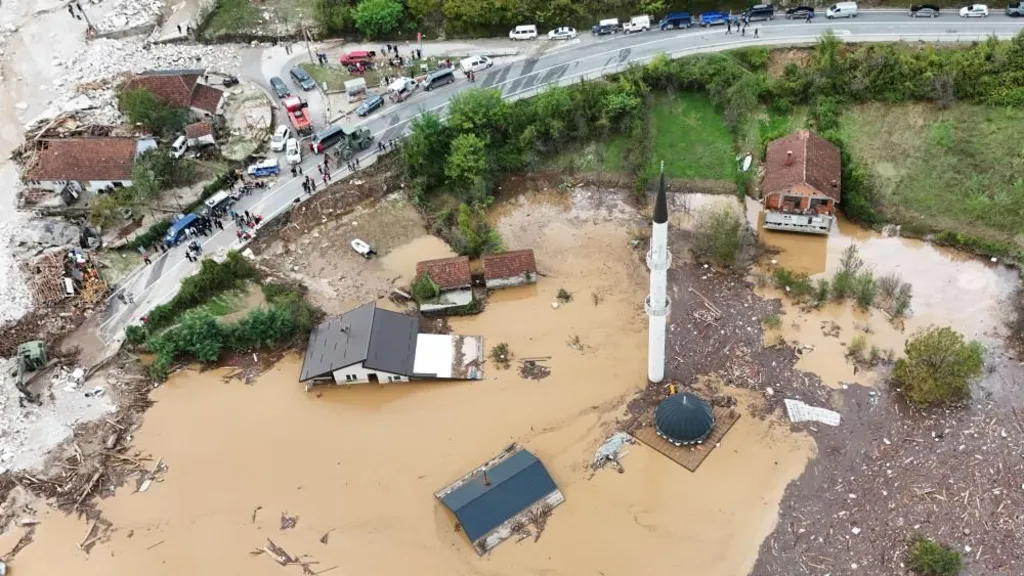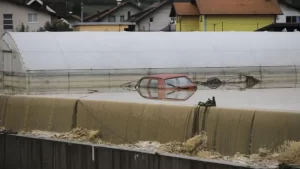Floods and landslides leave 16 dead in Bosnia
3 min read
Flooded houses after a heavy rain in the village of Luke, near Bosnian town of Fojnica.

Flooded houses after a heavy rain in the village of Luke, near Bosnian town of Fojnica.
Severe flash floods and landslides in central Bosnia-Herzegovina have resulted in the tragic deaths of at least 16 individuals, with entire towns and villages cut off and many homes nearly submerged. The situation has prompted a state of emergency as authorities grapple with the extensive damage caused by the relentless storms.
The hardest-hit area appears to be around Jablanica, a town situated on the critical route connecting the cities of Mostar and Sarajevo, approximately 70 kilometers (40 miles) northeast. Reports indicate that multiple individuals remain unaccounted for, further intensifying concerns over the disaster’s impact.
Development Minister Vojin Mijatovic described the situation as a “terrible disaster” and urged the public to remain calm amidst the chaos. Officials from the Herzegovina-Neretva Canton later clarified that while earlier reports indicated 16 fatalities, 13 confirmed deaths were associated with that region, along with three additional fatalities in the town of Fojnica.
Ongoing search and rescue operations are underway, with ten people still missing in the Herzegovina-Neretva Canton. The extreme weather has overwhelmed local infrastructures; rivers burst their banks following a sudden and intense overnight storm, inundating numerous towns and villages.
Aerial footage captured the scale of the devastation, showcasing vast areas submerged under water. Roads, bridges, and railway tracks have been either washed away or blocked by debris. Landslides have buried houses beneath rocks and soil, reaching as high as their upper floors. The main M-17 route, which runs parallel to the River Neretva, has been particularly affected, with significant debris covering the road near Jablanica. Furthermore, a critical 17-kilometer stretch of railway sustained substantial damage between Ostrozac and Grabovica, with one 200-meter section left precariously hanging in mid-air due to a landslide.
Local authorities in the Herzegovina-Neretva Canton have warned drivers to steer clear of hazardous roads around Jablanica, highlighting the ongoing risks as recovery efforts continue.

Further east along the Neretva River, a local resident recounted their harrowing experience to Bosnian media. The floodwaters surged into their home around 3:30 a.m. on Friday, forcing them to escape with their son just moments before their house collapsed.
The flooding crisis extends beyond Bosnia; in neighboring Montenegro, heavy rainfall has led to washed-away roads, isolating the village of Komarnica. Additionally, rising water levels in some rivers in Croatia have prompted warnings, particularly in the city of Karlovac, where there is a risk of flooding near the Kupa River.
This surge in flooding is part of a broader pattern affecting Central Europe. Last month, several countries, including Poland, the Czech Republic, and Romania, experienced significant flood damage. Scientists from the World Weather Attribution (WWA) group noted that a particular four-day period during that time was the rainiest ever recorded in the region, attributing the exacerbation of these floods to climate change.
The impact of climate change is increasingly evident, as Europe is recognized as the fastest-warming continent. The Copernicus climate service reports that the last five years have averaged approximately 2.3 degrees Celsius warmer than the latter half of the 19th century.
As Bosnia and its neighbors face the aftermath of this disaster, the urgent need for improved infrastructure and disaster preparedness becomes clear. The ongoing challenges underscore the vulnerability of these regions to extreme weather events, necessitating a robust response from local, national, and international authorities.
The tragic loss of life and the widespread destruction caused by these floods serve as a poignant reminder of the growing impact of climate change on our world. As recovery efforts progress, the focus will not only be on rebuilding but also on implementing strategies to mitigate future risks associated with severe weather patterns.